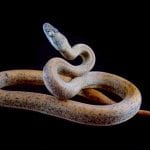Parents usually get requests from their kids about keeping a pet, and usually, they would think of a regular pet like a pet cat, dog, or bird. But not all kids prefer regular pets and would insist on getting an exotic one like a pet frog perhaps.
Possibly the child may have seen videos or pictures of a cute and colorful frog on TV or the web and immediately thought if he could keep one. Or, he may have a playmate or classmate with a colorful frog pet. But parents do consider the advantages of keeping a frog as a pet:
- Frogs don’t need much space to keep like a dog or a cat.
- Frogs don’t need a lot of attention like a regular pet.
- Frogs don’t need to be walked and played with daily.
- Frogs won’t cost too much to feed.
- Frogs are interesting and can improve your child’s knowledge about nature.
- Frogs are handy and can be transported even in your pocket!
- Frogs are colorful, and we have five of the most colorful frog pets for young keepers.
Top 5 most colorful frog pets for kids
1) Horned Frogs
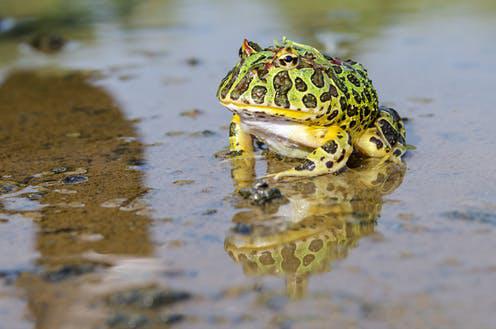
Horned frogs (Ceratophrys sp.) is also called a Pacman frog because these grow large and have a large mouth like the video game character. Pacman frogs spend their day burrowing into moss or soil and, of course, basking under the sun or a UV light.
This frog is usually green with dark spots, but it is common to find color morphs such as tri-color, fantasy, or albino. A horned frog can grow up to 8 inches in length and can be feisty, but when you hold it early from behind then, it will be used to your handling.
We included the horned frog as a good frog pet for kids because of its lovely color and its ease of care compared to other frog species.
Housing a horned frog
Pacman frogs can be kept inside a glass terrarium. Glass is perfect because it allows heat to dissipate, and thus the enclosure is cooler. You may also use wooden enclosures, but make sure to enhance ventilation since this type of housing is efficient in keeping heat.
A good size for an enclosure is at least 600 mm long and 300 mm high. Since this frog will grow big, these will need a larger enclosure to move around. Therefore, it’s best to start in a large enclosure.
Heating of a horned frog
This frog needs a constant air temperature of 75 degrees Fahrenheit and to achieve this, a heating mat should be installed on one wall of the glass enclosure. Most heating mats come with a thermostat, so you must make sure that the thermostat remains constant throughout the day.
The enclosure glass is heated from only one of its sides, so the horned frog can choose to move closer to the heat to warm itself or move away if it wants to be cooler. If you have a bigger enclosure and the heating mat is not cutting it, use a basking lamp. Just make sure that the temperature does not go above 80 degrees Fahrenheit.
Diet of a horned frog
It is very easy to feed a horned frog. These are carnivorous animals, and it’s meal consists of live insects and worms. The diet should be high in protein and must be easy on the digestive system. The best ones are brown crickets, but black crickets and locusts are also acceptable. Add other live food like waxworms and mealworms but do so occasionally.
For added protein, feed it earthworms or pinkie mice. Dust food with supplements such as calcium supplements. Gut load your insects with a nutrient-rich diet before feeding to your horned frog.
Tank accessories for a horned frog
The tank of a horned frog should be kept moist, and one way to do this is to use a combination of damp moss and bark chips as a substrate. This lining can be removed easily, re-soaked, and replaced when it’s necessary.
The frog tank may be decorated with plastic plants to recreate a natural look. You can use natural wood that provides areas where the frog can perch or bask. You can use trailing plants to hide electrical wires and other equipment. If your frogs breed, baby frogs can use these plants for cover.
2) Gray Tree Frogs
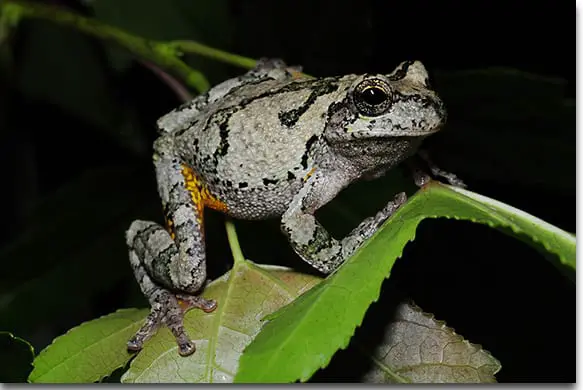
The Gray Tree Frog (Hyla chrysoscelis) is a small frog that lives mainly on trees. It is native to Canada and North America and is known as the smallest arboreal frogs included in our list. It is also quick and quite difficult to capture, and handling may become too stressful. These are not interactive pets, but don’t worry; as long as you provide these with a good enclosure, then these will be happy to be with you.
The color of gray tree frogs will charm you. These are not gray but come in light to dark brown with lovely deep brown eyes. The frog’s body is covered with all kinds of marks, and its arms have stripes from the fingers going to the body. The sides of the frog’s face are a dark shade of brown, and this helps make this species more stunning.
Some gray tree frogs come in shades of green and gray. Some may even be off-white and thus are too pretty to pass.
Housing a gray tree frog
The Gray tree frog is ideally kept in glass terrariums or enclosures. Just like the horned frog, the gray tree frog needs consistent air temperature daily, and glass is capable of allowing heat to dissipate. This way, the enclosure remains cool even during the warmest time of the day. Wooden terrariums may also work, but these tend to retain heat and thus could become too uncomfortable for your pet.
The size of a gray tree frog’s enclosure should be 300 mm long and 450 mm high. This is so because this frog will grow up to 1.5 to 3” therefore they need enough space to move about. The enclosure is higher than most frogs’ because these are arboreal frogs that require a high area where they can climb.
Heating for a gray tree frog
Like the horned frog, the gray tree frog requires a constant air temp of 75 degrees Fahrenheit. You can place a heating mat on one side of the terrarium; this device is regulated by a thermostat so that the temp remains constant all day long.
And since the glass is heated on one side, the frog can move towards the warm area if it feels cold or it wants to correct its body temperature. It can also hop over the cooler part if it wants to remain cool. You may use a heating lamp with a basking bulb if you have a larger enclosure or a heating map is not sufficient. Just make sure that the temperature does not exceed 80 degrees Fahrenheit.
Lighting for a gray tree frog
Gray tree frogs live in jungle areas in the USA, and in their natural habitat, they have a natural cover but still receive ample amounts of UV rays. You need to install a UVB source which should be installed in a canopy located above the top of your enclosure.
Gray tree frogs need UVB to make vitamin D3 in their skin. This vitamin is needed to absorb calcium for bone growth and development. If you can’t provide adequate UVB, then this frog may suffer from metabolic bone disease. Use t5 tubes replaced regularly every 9 months.
Diet of a gray tree frog
The gray tree frog’s diet is one of the easiest to follow because it is carnivorous. Its favorite are live foods that are high in protein and should be very efficient to digest. Just like horned frogs, brown crickets, black crickets or locusts are the most common type of live food for gray tree frogs. You may also feed these frog waxworms, mealworms, and calci-worms.
Tank accessories
The ideal substrate is a moist one, which can increase the humidity inside the enclosure. Use orchid bark because it is loose and easy to clean. You can also add moss. Gray tree frogs are arboreal, and so you’ll find them up on trees. Your enclosure must have tall pieces of wood to allow them to climb. You may use artificial plants to give them cover and for disguising any wires and electrical equipment.
3) Dart Frogs
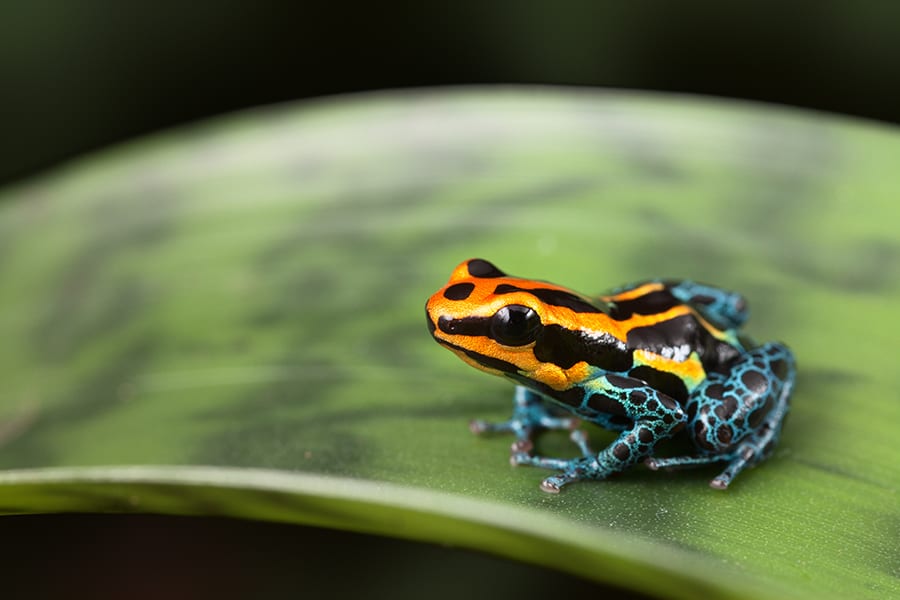
Nothing can be as colorful as a dart frog (Dendrobates sp.) or a poison arrow frog. There are different species of dart frogs, and as expected, these come in all kinds of bright colors, including stunning red, very deep blue, and striking green and gold. When dart frogs are bred in captivity, they lose their poisonous characteristics; this is because jungle or wild dart frogs become poisonous because of their diets.
Dart frogs prefer to live in a terrarium with high ceilings, live plants, climbing areas, and a small water feature where they can spend the day cooling off. Thus, it makes this species easier to care for dart frogs because you can purchase a ready to use bioactive terrarium. All you need to do is to add your pet!
Housing dart frogs
A glass terrarium is preferred because glass can allow excess heat to escape. Wooden enclosures can retain heat and thus can only make your pet overheat. You can find ready-made glass terrariums available in most pet shops and online pet stores.
The size of the glass terrarium should be 450mm long and 300mm high. This frog will grow up to 2” long, so these will require plenty of space to move about. A taller enclosure is recommended so you can set up tall live plants where the frogs can climb on and survey its environment. Then, a large enclosure is a good idea, so you can add a deep vat where the dart frogs can swim or get water from.
Heating of dart frogs
Dart frogs require constant air temperature of 75 degrees Fahrenheit, and this is achieved with a heating mat with a thermostat. If this is insufficient or you have a larger enclosure, you may add a basking lamp. With a heating mat on one side of the enclosure, the frog may choose to stay in the heated area, or it can remain in the cooler area if it is too warm. Make sure that the temperature remains 72 to 80 degrees Fahrenheit.
Diet of dart frogs
Dart frogs have a voracious appetite and will eat mainly insects; however, these won’t eat live food that is bigger than their mouth. So instead of large crickets, feed it micro crickets and flies. But take note, you can’t go on buying insects to feed your pet. You can grow your food or buy plenty of food like crickets and keep these healthy and delicious for your frogs.
Crickets should be fresh and juicy by feeding these fresh vegetables, fruits, and a product known as Bug Grub. Don’t allow crickets to dehydrate because you don’t want to feed your dart frogs nearly dead food. Use Bug Gel, a product that can keep insect food longer. Place insect food inside a plastic enclosure where they can remain safe and healthy until dinner time.
Tank accessories
Dart frogs are fun to watch because of their lovely colors, so don’t let the tank décor steal the show. Do not over-decorate your tank. Use bark chips and moist moss as bedding because these can be re-soaked or replaced easily.
You may use artificial plants or live plants to create a natural rainforest theme, but be careful in placing different ornaments because these may fall on your pet! Secure your décor with wires so your pet can remain safe.
4) Red-Eyed Tree Frog
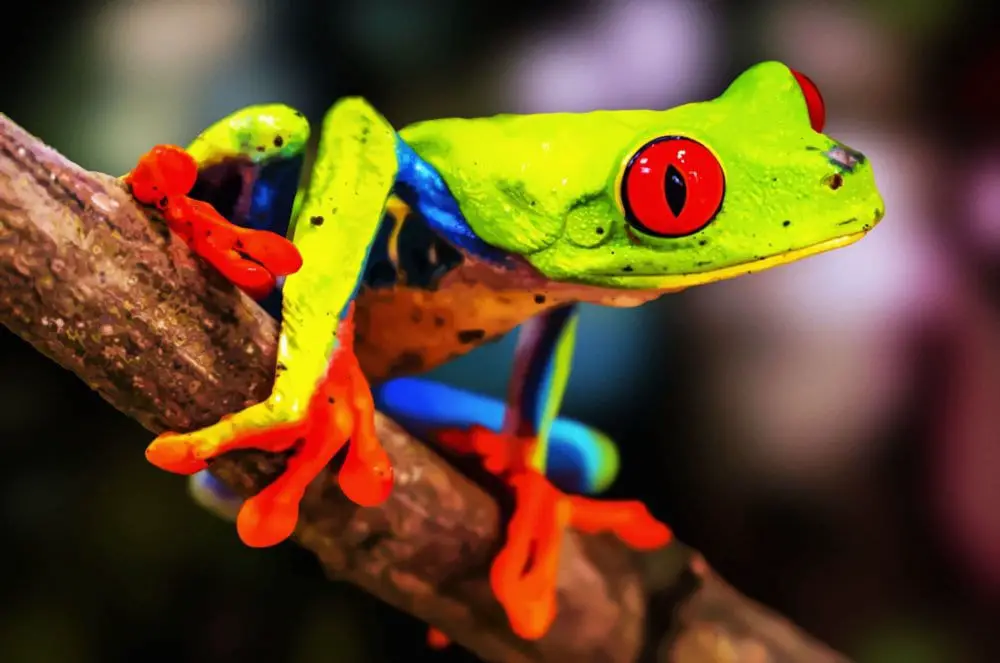
The red-eyed tree frog (Agalychnis callidryas) may be the most popular colorful frogs. The body has a bright green color with a yellow belly and stunning red eyes. The hands and feet are bright red. The upper arms have bright blue colors while the sides come with black bars.
Children may be familiar with this frog’s appearance from books, cartoons, and movies, and if this is what your young pet lover wants, then you’re in luck. This species may look exotic but is very easy to care for and have very basic needs.
Take note that tree frogs may be handled, but most prefer to let them be inside their enclosure. You can make it happy by providing an enclosure with live plants, an elevated area where it can bask or survey its area, and a small water feature where it can wade in shallow water.
Housing a red-eyed tree frog
Like most frogs on our list, a red-eyed tree frog will do well inside a glass terrarium. Glass can dissipate heat and thus will not cause the interior of the enclosure to overheat and harm your pet. A wooden terrarium is not a good idea because it can retain heat with its thick, opaque walls.
The enclosure must be 450mm long and 600mm high. A red-eyed tree frog will grow up to 3 inches and thus need space where it can live, move around and hunt. Also, this arboreal frog needs a taller enclosure so you can add tall plants where it can climb on to.
Heating a red-eyed tree frog
Maintain an air temperature of 75% and canopy temperatures from 75 to 80 degrees Fahrenheit. You can do this by placing a heating mat on one of the sides of the enclosure. This way, the frog can move from one cooler area to a warmer area. But if you have a larger enclosure, add a basking lamp to improve the temperature.
Diet of a red-eyed tree frog
Red-eyed tree frogs are carnivorous and thus need live food to eat. You can feed it brown or black crickets and locusts. You may also offer mealworms, calciworms, or waxworms on occasions. Food must be the size of the space between the frog’s two large and colorful ears. To help the frog drink, mist the inner part of the enclosure in the morning. You may also place a water bowl in the middle of the enclosure. Adding calcium supplements, vitamins, and minerals are vital to caring for a red-eye tree frog. These supplements should be dusted on food before feeding your pet.
Tank accessories
A coarse and thick substrate like orchid barks is good bedding. You may also add moss to improve moisture. You can add pieces of wood so that the frog can perch. Use artificial plants or live plants inside the tank.
5) Whites Tree Frog
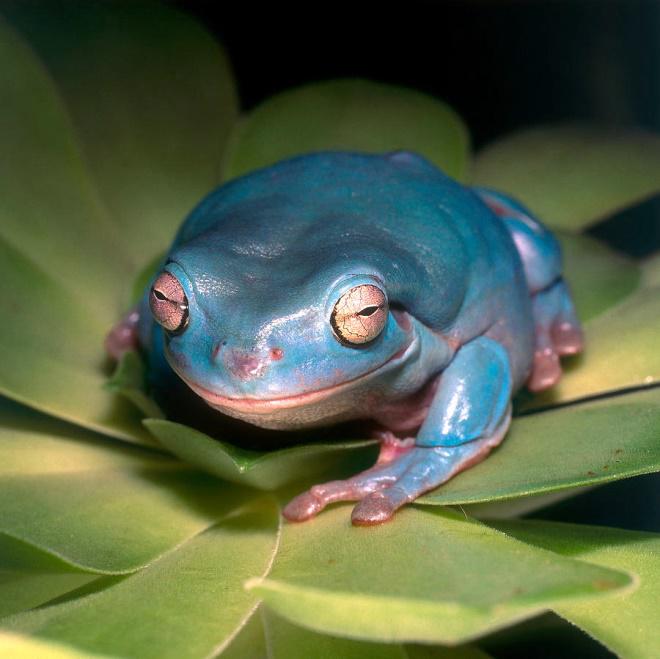
Whites tree frog (Litoria caerulea) is a large arboreal frog that can be blue or green with white bellies. This is a large arboreal species of frogs that can grow up to 5 inches in size. It moves slow and is quite lazy, so it’s easy to catch and handle.
Housing a whites tree frog
A whites tree frog can be housed inside a glass terrarium. Just like all frogs in our list, this is the most preferred form of housing because glass is capable of dissipating extra heat, unlike wood that will only retain heat. And besides, whites tree frogs are far more colorful to house inside a wooden vivarium, right?
The terrarium must be 450 mm long and 600 mm high so that the frog can have more space considering that adults can grow up to 4” long. Also, the whites tree frog is arboreal, and thus it needs a high area inside its enclosure where it can climb and survey its environment.
Heating for a whites tree frog
Maintain a constant 75 degrees Fahrenheit air temperature inside the vivarium. You can do this by sticking a heating mat on one side of the enclosure. This will help create a temperature gradient inside the terrarium so that the frog can move in a cold or a warm area if it wants to.
Sometimes, if your tank is still too cold because of the climate or you just have a large tank, you can install a basking light/lamp. It may be placed on the canopy, but the temperature should not be higher than 75 to 80 degrees Fahrenheit.
UVB lighting for whites tree frogs
White tree frogs are from Australia, and these are found in jungle areas with natural cover. However, these colorful frogs still get fair amounts of UV light. You must add a UV light and installed in a canopy that’s above the ceiling. Use a 5 to 6% UV lamp or any equivalent compact fluorescent lighting.
Just like other arboreal frogs, whites tree frogs need UVB light so they can synthesize their vitamin D3. This vitamin is needed by animals to absorb more calcium for bone growth and development. If your pet does not get enough UVB, it can suffer from metabolic bone disease.
Diet of a whites tree frog
Mist the terrarium every morning for hydration. Frogs will simply lick water from their bodies or on the tank and accessories to drink. You may add a bowl of water as a good source of clean, freshwater. Whites tree frogs prefer live food because these are carnivorous. The best kinds are brown and black crickets, mealworms, calci-worms, and waxworms. The diet of whites tree frogs should be small enough to eat and should be high in protein. A good way to measure food is that it should be the size of the distance of a frog’s eyes.
Tank accessories
Use loose and coarse orchid bark as a substrate. This is easy to clean and replace. If you want to correct poor humidity, add moss to the substrate. Use natural wood and artificial plants to decorate the enclosure. Use vines or trailing plants to hide wires and other tank equipment. Young frogs can also use artificial plants as a cover.
So which colorful frog did you choose? Don’t forget to buy only from a reputable pet shop where they sell healthy pets. You can also buy from reputable online exotic pet shops.

